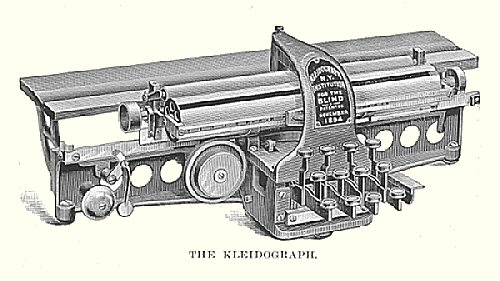Kleidograph 1894
In 1894, after three years of effort, William Bell Wait invented the Kleidograph, a machine for embossing the New York Point system on paper. The machine was sold by the school and was designed for the user to use it with one hand leaving the other free to read. It uses the eight point alphabet not the six dots that the Braille alphabet uses today. The four lower keys activate the two keys above, enabling one to emboss all eight dots with the right hand. The two left keys were used for punctuation and the wooden board surface allowed to user to read what was typed on the paper.
 New York Point was widely used by schools for the blind in the United States in the late 1800’s. The 1910 US Census lists 57% of respondents using the code. Mary Ingalls, the sister of Laura Ingalls Wilder author of the Little House books, learned New York Point and embossed letters at Iowa Braille and Sight Saving School in the late 1870’s and 80’s. The code was in common use by the majority of schools for the blind until the movement for a single world wide English language code took root in 1916.
New York Point was widely used by schools for the blind in the United States in the late 1800’s. The 1910 US Census lists 57% of respondents using the code. Mary Ingalls, the sister of Laura Ingalls Wilder author of the Little House books, learned New York Point and embossed letters at Iowa Braille and Sight Saving School in the late 1870’s and 80’s. The code was in common use by the majority of schools for the blind until the movement for a single world wide English language code took root in 1916.Information on the web on the Kleidograph
- http://www.antiquetypewriters.com/
- http://www.aph.org
- http://www.collectorsweekly.com/
- https://books.google.com - NYIB 1900 Annual Report


